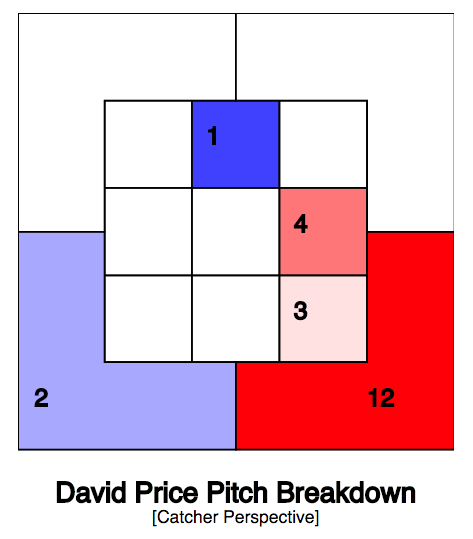David Price's Changeup Is Helping Him Stay Elite

The Boston Red Sox gave free-agent lefty pitcher David Price a massive contract this offseason to help improve a starting rotation that posted a 4.39 ERA in 2015, which ranked seventh-worst in the league.
Through three starts this season, Price has a 4.50 ERA -- not exactly what fans expect from a guy making $31 million a year.
Luckily, we don’t rely on ERA as the sole barometer of success. Price’s high ERA appears to be inflated, as his Expected Fielder Independent Pitching (xFIP) is 2.12, which is fourth-best this season. He’s also leading baseball with 27 strikeouts, and his 36.5 strikeout percentage (K%) is currently fourth-best. (For reference, the league average K% in 2015 was 20.4 percent).
There’s lots to like about what Price has done so far in 2016, and much of it can be attributed to the success he’s had with his changeup.
Baseball's Best Changeup?
Price has eight strikeouts via his changeup, which is the most of any of his pitches, and he’s generating a ton of swings from this pitch. When Price throws his changeup, batters swing a whopping 59.5 percent of the time, and they’re not finding much success.
Price’s overall swinging strike percentage (SwStr%) this season is 15.3, which is sixth-best among starters, but this number jumps to 27.8 percent against his changeup.
He’s created 22 swings and misses on his changeup, which currently leads all of baseball, according to Baseball Savant.

The image above shows that roughly 55 percent (12 of 22) of the swings and misses Price has created off of his changeup come from one quadrant -- down and in on lefties and trailing away from righties. Considering the horizontal movement on his changeup is fourth-highest among starters this season, it’s understandable why hitters on both sides of the plate are struggling to make contact with it, despite a decrease in his overall velocity.
The sample size is just three starts, but so far this season, Price’s velocity is down across the board. His average fastball velocity is just 91.4 miles per hour, which is only 50th-hardest this season, and the average velocity of his changeup is 83.4 miles per hour, which is 61st-hardest.
However, of all of the pitchers who are throwing their changeup at least 20 percent of the time this season, Price has the 10th-largest difference in fastball velocity to changeup velocity. And that leads to lots of swings and misses.
Price had his stuff today. 🔥🔥🔥 https://t.co/8BwzvAjvYI
— Boston Red Sox (@RedSox) April 17, 2016
Notice the two strikeouts in this clip against top hitters
Edwin Encarnacion and Jose Bautista. Both were against fastballs, neither of which were thrown harder than 93 miles per hour. Despite not throwing hard, the difference in speed of Price’s two most frequently thrown pitches (his fastball and changeup) makes his fastball seem faster than it is and, thus, harder to hit.
When Price’s changeup is effective, he has the ability to neutralize even the most potent offenses, like he did to the Toronto Blue Jays on Saturday (7 innings, 6 hits, 2 runs, 9 strikeouts, 0 walks), despite not throwing it often until the past few seasons.
More Changeups, More Success
Price began his career rarely throwing his changeup. In his first two full seasons in the Majors, 2009 and 2010, Price threw his changeup 6.4 percent and 5.5 percent of the time, respectively, but began increasing its frequency every season since. In 2015, he threw it 22.7 percent of the time -- his first season above 20 percent -- and he currently sits at 25.5 percent in 2016, which is seventh-most.
It was not until the 2014 season that it became his second most frequently thrown pitch.
Considering the success he’s had with his changeup in the past (a 19.54 swing and miss rate in 2015, according to Brooks Baseball) and how well he’s thrown it in 2016, the future looks bright for Price, despite turning 31 years old this August.
The more he continues to master his changeup -- which has become one of baseball’s best -- the less the decrease in his velocity will matter, something I’m guessing the Red Sox took into account when signing him to a deal through his age-37 season.
Price threw his fastball 53.4 percent of the time last season, which was the 29th-fewest among qualified starters and a career low, but he also posted a career best 6.4 Wins Above Replacement, according to FanGraphs. This season Price is currently throwing his fastball 53.2 percent of the time.
We project him to post a 3.09 ERA with a 25.0 K% by year's end.
He finished second in American League Cy Young voting last season, and with his changeup clicking on all cylinders, look for Price to be right back in the running again in 2016.
















